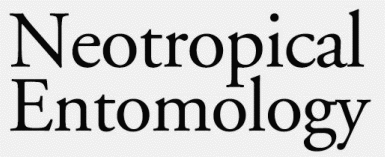Resumo em Português:
Aphidius colemani Viereck está entre os principais inimigos naturais utilizados no controle biológico de Aphis gossypii Glover. Os objetivos deste trabalho foram avaliar o desenvolvimento de A. colemani e as alterações causadas pelo parasitismo no hospedeiro A. gossypii em diferentes temperaturas e estimar as exigências térmicas do parasitóide. O experimento foi conduzido em câmaras climatizadas a 16, 19, 22, 25, 28 e 31 ± 1°C, com 70 ± 10% U.R. e fotofase de 12h. Ninfas de 2º instar de A. gossypii foram parasitadas uma vez e individualizadas em tubos de vidro (2,5 cm x 8,5 cm), contendo disco foliar de pepino (2 cm) e solução agar/água a 1%. O período da oviposição à formação da múmia (11,9; 9,8; 7,7; 6,4 e 6,4 dias) e o da oviposição ao adulto de A. colemani (19,4; 16,2; 12,6; 10,5 e 10,7 dias) diminuíram com o aumento da temperatura no intervalo de 16ºC e 25ºC. A porcentagem de múmias formadas e a de emergência do parasitóide, assim como a longevidade diminuíram com o incremento da temperatura. Não houve formação de múmias a 31°C. O parasitóide A. colemani apresentou temperatura base inferior de desenvolvimento de 5,94°C e constante térmica de 200 GD. As alterações ocasionadas no hospedeiro A. gossypii pelo parasitismo foram minimizadas na temperatura de 31°C, sendo que 98% dos hospedeiros não apresentaram sintomas de parasitismo e produziram ninfas. A temperatura de 22°C foi a mais adequada para o desenvolvimento de A. colemani.
Resumo em Inglês:
Aphidius colemani Viereck is among the main natural enemies used for biological control of Aphis gossypii Glover. The objective of the present study was to evaluate the development of A. colemani and the alterations caused by the parasitism in the host A. gossypii in different temperatures and to estimate the thermal requirements of the parasitoid. The experiments were carried out in controlled environmental chambers at 16, 19, 22, 25, 28 and 31 ± 1ºC, 70 ± 10% RH, and 12h photophase. Second-instar nymphs of A. gossypii were parasitized once and kept individually in glass tubes (2.5 cm x 8.5 cm), containing leaf disc of cucumber (2 cm) and 1% water/agar solution. The development time of A. colemani, from oviposition to mummies (11.9, 9.8, 7.7, 6.4 and 6.4 days) and from oviposition to adult (19.4, 16.2, 12.6, 10.5 and 10.7 days) decreased with the increase of the temperature from 16ºC to 25ºC. The rates of mummies and the emergence of the parasitoid, and its longevity also decreased with the increase of the temperature. Mummies were not produced at 31ºC. The lower temperature threshold of A. colemani was 5.94ºC and its thermal constant was 200 degrees-day. The alterations caused by the parasitoid in the A. gossypii host were minimized at 31ºC, where 98% of the host did not show symptoms of parasitism and produced nymphs. The temperature of 22ºC was optimal for the development time of A. colemani.
